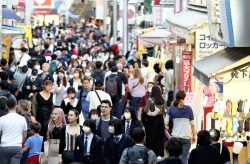17:05 JST, February 28, 2025
How should a society be created in which many young people want to have children? Measures to maintain national strength and sustain the social security system should be devised.
The government has released the preliminary figures of Japan’s vital statistics for 2024. The number of births last year decreased by 5% from the previous year to 720,988, a record low for the ninth consecutive year.
The rate of decline in births has been particularly serious in recent years. Since 2022, the number of births has declined by 5% or more for three consecutive years.
Since 2020, when the COVID-19 pandemic began, opportunities for people to meet in person have been restricted, and encounters between men and women have also decreased. Not a few have also postponed their marriages. Such effects of the pandemic may be one of the factors accelerating the low birth rate.
The preliminary figure includes the number of babies who are counted as foreign residents. The number of births is expected to fall below 700,000 for the first time in the finalized figure, which will be released in June, comprising Japanese nationals alone.
The number of couples who got married last year was almost 500,000. This was a 2% increase from the previous year, when the postwar low was recorded, but still the second lowest level in the postwar period.
If the number of marriages continues to stagnate, a recovery in the number of births would be unlikely.
When young people get married, they probably prioritize first whether they will be able to lead a stable life after marriage.
According to a survey by the Internal Affairs and Communications Ministry, 60% of men aged 30-34 working as regular employees are married, but only 20% of male nonregular workers in this age group are married.
For unmarried women in their late 20s, 60% of those working as regular employees said they want children, while only 40% of those working as nonregular employees said the same.
Increasing the number of regular employees is essential to stabilize the lives of the younger generations.
There also is an estimate that Japan’s population is expected to halve to around 60 million by the end of this century. That would be the same level as in 1930. However, at that time, people aged 65 or older accounted for a little less than 5% of the total population, a figure that is expected to reach 40% by the end of this century. This means that a small number of people in working-age generations will support a large number of elderly people.
The number of people in younger generations who do not have children is also increasing. Although their circumstances may vary, they also will use public services, such as pensions, medical and nursing care, when they reach old age. Young people must not forget that the declining population is their own problem as well.
Large-scale measures decided by the Cabinet of former Prime Minister Fumio Kishida to combat the low birth rate focused on economic support, such as the expansion of child allowances and improving parental leave benefits.
It is necessary to analyze various factors behind the continuing low birth rate and review them from a comprehensive perspective.
(From The Yomiuri Shimbun, Feb. 28, 2025)
"Editorial & Columns" POPULAR ARTICLE
-

Violations of Subcontract Law: Major Automakers Must Eliminate Old Practices
-

Local Governments’ Tax Revenues: Devise Ways to Correct Imbalances in Tax Sources
-

5 Japanese Business Dinner Mistakes to Avoid — and What They Taught Me About Business in Japan
-

Heavy Rains in Asia: Support for Victims, Flood-Control Measures Urgently Needed
-

New Nuclear Threat: China Seeking to Follow U.S., Russia in Military Expansion
JN ACCESS RANKING
-

Keidanren Chairman Yoshinobu Tsutsui Visits Kashiwazaki-Kariwa Nuclear Power Plant; Inspects New Emergency Safety System
-

Imports of Rare Earths from China Facing Delays, May Be Caused by Deterioration of Japan-China Relations
-

University of Tokyo Professor Discusses Japanese Economic Security in Interview Ahead of Forum
-

Japan Pulls out of Vietnam Nuclear Project, Complicating Hanoi’s Power Plans
-

Govt Aims to Expand NISA Program Lineup, Abolish Age Restriction





















